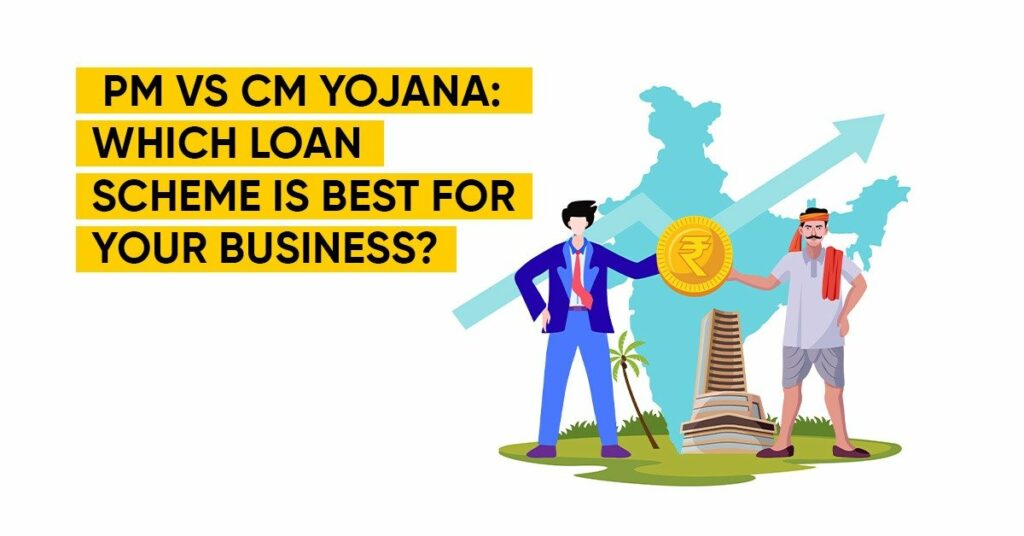Why compare PM Vs CM Yojana Loan Schemes in 2025?
Did you know there are 63 million MSMEs in India and they make just under 30 percent of our GDP? That’s huge! However, one of the greatest problems most of these businesses have to deal with is access to timely credit.
That is where government loan schemes in India 2025 come in. But the real question I am hearing over and over again is this:
👉 “Which one is better for me—PM Vs CM Yojana loan schemes?”
It is a legitimate doubt since the central government provides huge ticket schemes under the PM Yojana whereas the state governments have their own customised CM Yojana schemes. And whether you have a small export business, a startup or even a local trading company, knowing the difference can make the difference in loan approval.
And now, let us analyze this, step by step.
👉Create Your Bank-Ready Project Report in Minutes
Understanding PM Vs CM Yojana Loan Schemes
Consider PM Yojana Vs CM Yojana business loans to be two sides of the same coin. Both are aimed at empowering MSMEs and startups, however, they have different scope and implementation.
- PM Yojana (Central Government Schemes): These are schemes that are countrywide loans such as PMEGP, Mudra Yojana, and Stand-Up India. Anyone all over the country can apply
- CM Yojana (State Government Schemes): These are state government schemes such as the Telangana CM Yojana or the Tamil Nadu Entrepreneur Development Scheme, and are meant to help local businesspeople.
In brief, Central Vs State government loan schemes are different at the level of scope. Central schemes cover a wider area whereas state schemes are more industry-oriented and localized.
What is PM Yojana Loan Schemes?
Now, here is a quick overview of what PM Yojana has to offer in 2025. These are some of the best loan schemes for MSMEs In India:
- Pradhan Mantri Mudra Yojana (PMMY): 10 lakh rupees loans in three categories, Shishu, Kishore, and Tarun. Ideal for small traders, service providers and traders.
- Prime Minister Employment Generation Programme (PMEGP): Loan of up to 25 lakhs in manufacturing and 10 lakhs in services with a subsidy of up to 35%.
- Stand-Up India Scheme: This scheme is dedicated to SC/ST and women entrepreneurs and provides loans of 10 lakh to 1 crore.
These schemes are strong since they do not only offer funds, but also give credibility when you are applying bigger loans in future.
What is CM Yojana Loan Schemes Overview
On the one hand, CM loan schemes for small businesses (SERP) and startups are also equally effective, however, they are more region-specific.
Some examples are as follows:
- Telangana CM Loan Scheme: It offers interest-free loans to women SHGs and local traders.
- Tamil Nadu NEEDS Scheme: Provides a grant to first generation entrepreneurs to start new business.
- Kerala CM Entrepreneurship Development Scheme: Seed capital and soft loans are provided.
Whereas PM schemes are generalized, CM schemes are specific to your state economy, industries, and local problems.
👉 See how to measure small business performance effectively.
PM Vs CM Yojana Loan Schemes: Comparison Table
To make this clearer, let’s do a PM loan schemes comparison with CM loans side-by-side:
| Feature | PM Yojana Schemes (Central) | CM Yojana Schemes (State) |
| Coverage | Pan-India | State-specific |
| Loan Size | ₹50,000 – ₹1 crore | ₹50,000 – ₹50 lakh (varies) |
| Focus Areas | MSMEs, Startups, Women, SC/ST | Local trades, state industries, youth |
| Approval | Nationalized banks, NBFCs | Cooperative banks, state banks |
| Example | PMEGP, Mudra, Stand-Up India | Telangana CM Yojana, NEEDS |
As you can see, both have their strengths. If you’re aiming big, central schemes give you scale. If you’re aiming to start small and steady, state schemes might be the right choice.
PM Yojana Vs CM Yojana Business Loans: Key Differences
So, what are the most significant differences when we speak about PM Yojana Vs CM Yojana business loans? So, how can they be broken?
- Loan Approval Process: PM processes are more structured and can be time consuming. The localized processes may make schemes faster.
- Accessibility: Everyone can apply to central schemes, although CM loans can be granted to local residents and/or to specific groups.
- Collateral: Most PM schemes are collateral-free as opposed to CM schemes which still may require guarantees.
- Support: There are mentorship, training and subsidies that are often accompanied with state schemes.
- Flexibility: Central schemes cover almost every sector, while CM schemes focus on industries relevant to that state.
How to Apply: PM Vs CM Yojana Loan Online Apply
Now let’s get practical. How do you apply for these loans?
For PM Vs CM Yojana Loan Online Apply, the process looks like this:
1.For PM Yojana (Central Government):
- Visit official portals like pmjdy.gov.in, udyamimitra.in, or msme.gov.in.
- Submit documents like Aadhaar, PAN, project report, and GST details.
- Banks/NBFCs review and approve.
2. For CM Yojana (State Government):
- Each state has its own online portal (e.g., Telangana’s TSOBMMS, Tamil Nadu MSME website).
- Requirements vary but usually include proof of state residency and a business project plan.
The digital push has made PM Vs CM Yojana loan online apply much easier in 2025.
Which Loan Scheme is Best for MSMEs?
Now comes the million-rupee question—Which is the Best Loan Scheme For MSMEs In India?
The answer depends on YOU:
- If you’re a startup founder in IT or fintech, PM schemes like Stand-Up India or Startup India might fit better.
- If you’re a local trader or artisan, a CM loan scheme for small businesses (SERP) could be more accessible.
- If you need big funding for manufacturing, PMEGP or SIDBI loans may be best.
- If you’re a street vendor or micro business, PMMY or PM SVANidhi is perfect.
So instead of thinking one is “better” than the other, think of which one fits your business stage.
Conclusion: Choosing the Right Path for Your Business
At the end of the day, both PM Vs CM Yojana loan schemes have been designed to fuel India’s business ecosystem.
Central schemes (PM) give you nationwide credibility and larger funding. State schemes (CM) give you accessibility, local subsidies, and handholding support.
And remember, whichever you choose, the quality of your project report is what makes the real difference. A well-prepared, bank-ready project report increases your chances of loan approval dramatically. Platforms like Finline help you create such reports in less than 10 minutes, so you can focus on your business growth rather than paperwork.
👉 Your business deserves the right loan, and the right loan deserves the right project report. Curious about pricing? Click here.









